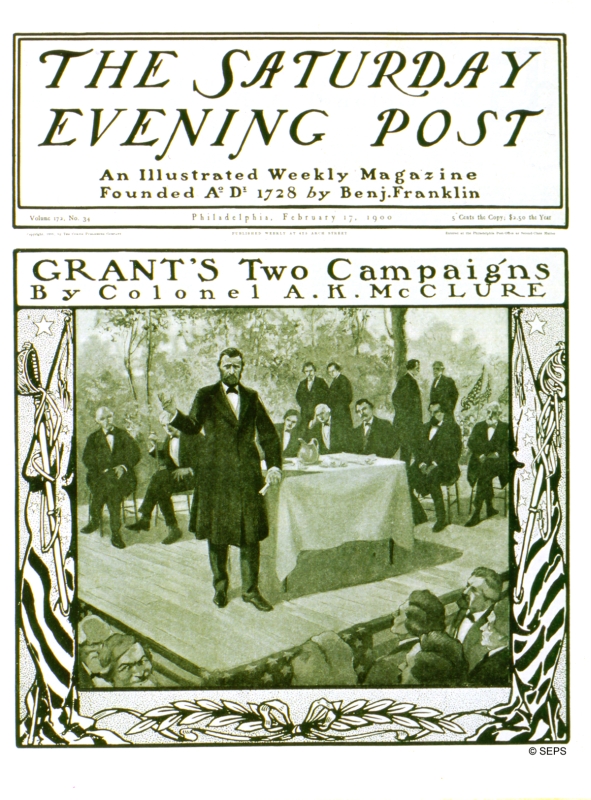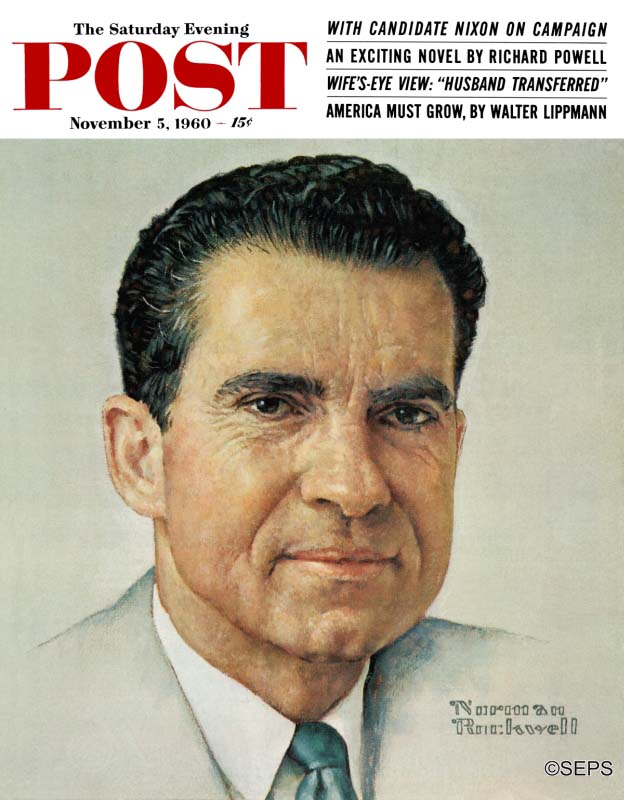Baseball: Opening Day
This article and other features about baseball can be found in the Post’s Special Collector’s Edition, Baseball: The Glory Years. This edition can be ordered here.

April 11, 1959
Richard Sargent
The stars generally find hidden resources on the third Tuesday in April, the day the sun always shines for the addicts. The excitement the fans have been building up for six months always spills over on the field and denudes the players of their studied nonchalance. Through the season the heroes cultivate a dead-pan attitude toward uproars in the stands, but their masks are left in the clubhouse on opening day.
“It’s just another ball game,” they say casually — the oldest, and truest, cliché in the trade. The first game is no more or no less important than the 153 that follow. Rookies bravely mouth the slogan and veterans may even believe it. But bushers and old pros alike are pushovers for the brass bands, the march to the flagpole, and the contagious enthusiasm of the fans. The emotional charge of opening day has inspired many of the most brilliant exploits on record. Year after year, it produces more hustling than the customers are likely to see the rest of the season — anyway until the World Series.
“You always get a special kick on opening day, no matter how many you go through,” Joe DiMaggio says. “There’s a lot of beefing during the season about sleeper jumps on trains, lousy hotel food, and living out of a suitcase half the year, but you forget the gripes on opening day. You look forward to it like a birthday party when you were a kid. You think something wonderful is going to happen.”
For all the natural drama that occurs at the season’s start, Clark Griffith probably deserves major credit for making opening day a national event. Griffith, owner of the Washington Senators, gave baseball a priceless public-relations boost when he conceived of the bright idea of having the president throw out the first ball.
The tradition which was instituted by William H. Taft in 1910 and has been observed every year since — pinch-hitters have acted for the president during wars and other crises — is by all odds the game’s best press-agent pitch.
— “Baseball’s Biggest Day” by Stanley Frank, April 12, 1952
Cover Gallery: Presidents
The Saturday Evening Post has featured many U.S. presidents on its cover in its nearly 200-year history. Here is a gallery of the men who have helped shape our nation.

By Karl Kleinschmidt
February 17, 1900
Fifteen years after his death and 23 years after leaving office, Grant appeared on the cover of the Post, in one of a series of articles by Colonel A. K. McClure on “How We Make Presidents.” Grant oversaw the elimination of Confederate nationalism and slavery, protected African-American citizenship, and supported industrial expansion.

By Sarony & Bell
March 24, 1900
The election of 1876 was one of the most contentious in U. S. history. It was one of only five elections in which the person who won the most popular votes did not win the election. At one point, Tilden had 19 more electoral votes than Hayes. But a deal was brokered in which 20 disputed electoral votes were awarded to Hayes in exchange for withdrawal of federal troops from the South, putting Hayes in the White House by one vote.

By Guernsey Moore
February 16, 1901
As he was handing over the reins of the presidency to his successor, John Adams, Washington wrote, “I hold the maxim no less applicable to public than to private affairs, that honesty is always the best policy.”

By George Gibbs
April 26, 1902
Grover Cleveland was only U. S. President to serve two non-consecutive terms in office. He appeared on seven Saturday Evening Post covers and wrote several articles for the magazine on hunting, fishing, and the plight of democracy (not necessarily in that order of importance). He is remembered for being the only president to marry while in the White House, and for his deathless statement, “What is the use of being elected or re-elected unless you stand for something?”

By J. C. Leyendecker
March 6, 1909
An article in this issue of the Post proclaimed Taft to be “the heaviest President, the most traveled President, the best-natured President and the first golf player to occupy the White House.” He was among the most amiable and least ambitious men to be elected to the office. He continued most of the policies of his predecessor and friend, Teddy Roosevelt, but the two became estranged and ran against each other in 1912.
All his life, Taft tried in vain to reduce his weight. He reached 355 pounds while he served unhappily as president. He was also the only president to also serve as a justice on the Supreme Court, where he was far happier.

By J. C. Leyendecker
October 26, 1912
The Post was fascinated and charmed by Theodore Roosevelt, an energetic, progressive, young president who interrupted the long line of serious old men in the White House. Post editorials applauded his campaigns against “malefactors of great wealth” and his enthusiasm for making the U.S. a global power. Coming to the presidency in 1901 after President McKinley was shot, he was elected to a full term in 1904. He stepped aside in 1908 to let his friend, William H. Taft, successfully run for office. But in 1912, when this boy carved his pumpkin with TR’s toothy grimace and pince nez glasses, he was trying unsuccessfully for another term.

By J. C. Leyendecker
February 12, 1938
In 1862, with the country at the end of a Civil War, Lincoln called on Americans to face the challenges ahead without looking backward. He also reminded members of Congress that they would all be remembered for what they did in those perilous times:
“The dogmas of the quiet past, are inadequate to the stormy present. The occasion is piled high with difficulty, and we must rise — with the occasion. As our case is new, so we must think anew, and act anew. We must disenthrall ourselves, and then we shall save our country.
“Fellow-citizens, we cannot escape history. We of this Congress and this administration, will be remembered in spite of ourselves. No personal significance, or insignificance, can spare one or another of us. The fiery trial through which we pass, will light us down, in honor or dishonor, to the latest generation.”

By John Launois
June 13, 1964
This photograph of former President Truman was taken in front of his Independence, Missouri home. In an article that Truman wrote for the Post, the 80-year-old looked back over his controversial career and explained the principles that guided him in making the most difficult decisions of his Administration — including the “firing” of Douglas MacArthur.

By Norman Rockwell
October 13, 1956
The Post hadn’t featured a sitting president on its cover since Taft’s appearance in 1909. A popular president, Eisenhower authorized the establishment of NASA, invoked executive privilege to help end McCarthyism, expanded social security, launched the interstate highway system, and established the Defense Advanced Research Projects Agency which led to the development of computer networking and graphical user interfaces.

By Norman Rockwell
October 29, 1960
Among his many better known accomplishments, Kennedy also won a Pulitzer Prize (for “Profiles in Courage”), was awarded a Purple Heart, and donated his salary to charity. He represented the new generation of politicians: he was young, good-looking, smart, and funny, and drew international admiration. Kennedy spoke of idealism at a time when the country wanted to move on to new horizons, but his aggressive stance against communism brought the country close to one war and involved it in another, in Vietnam.
This Rockwell portrait appeared a second time when the Post ran its memorial issue after Kennedy’s assassination.

By Blake Hampton
September 11, 1965
President Johnson was a politician’s politician, and he was a paradox. He was cynical and calculating enough to be a powerful force in Washington, but also a champion of the poor and the man who launched a “War on Poverty. Johnson signed several civil rights bills that banned racial discrimination in public facilities, interstate commerce, the workplace, and housing. He signed the Voting Rights Act and the Immigration and Nationality Act into law. When he came to the White House after Kennedy’s assassination, he enjoyed a long honeymoon period with the press. But he lost the support of the media, and many Americans, with his determination to continue sending American soldiers to Vietnam.

By Norman Rockwell
November 5, 1960
President Nixon is best remembered for the Watergate scandal and his subsequent resignation, but he also opened diplomatic relations with China, initiated détente with the Soviet Union, and established the Environmental Protection Agency. He ended U.S. involvement in Vietnam, and supported the Equal Rights Amendment, affirmative action, and the food stamp program. It was ironic that a man who rose in politics through his anti-communist stance made such significant progress with the communist governments of Russia and China.
Rockwell painted this portrait of candidate Nixon nine years before Nixon won the presidency.

By J. Moore
January 1, 1975
In this feature in the Post, “astrologer to the stars” Carroll Righter analyzed President Ford’s astrological profile, terming him a Moonchild. Ford has the distinction of being the only person to have served as both Vice President and President of the United States without being elected to either office. It has not been determined if the alignment of the stars or planets was a factor.
Entering the White House abruptly when President Nixon resigned, he drew broad support by pardoning the men who’d avoided serving in Vietnam by illegally dodging the draft. But much of his popularity melted away when he also pardoned Nixon, sparing the nation a long, rancorous, divisive spectacle of a trial.

By Lucian Lupinski
March 1, 1982
Once a Democrat, Reagan switched to the Republican party as his views became more conservative. As president, he supported Afghan rebels opposing Russia’s invasion of their land and pushed for a space-based missile system to protect America from a nuclear attack. In the end, though, he was the president whose policies and tactful diplomacy with Russian leaders would end the Cold War.

By Lucian Lupinski
October 1, 1988
George H. W. Bush appeared on the Post cover when he was still vice president, but was poised to win the presidential election, held a month later. He is the oldest living former president and vice president.
Bush continued many of Reagan’s policies, but he bridled when journalists compared him unfavorably to the charismatic Reagan. He was portrayed by some as being weak, sheltered, and a wimp. Yet it was Bush, not Reagan, who served in World War II and survived being shot down as a Navy pilot. His single term was noted for his authorization of the military overthrow of a corrupt dictator in Panama and the smashing of Iraq’s force in Kuwait though Operation Desert Storm.